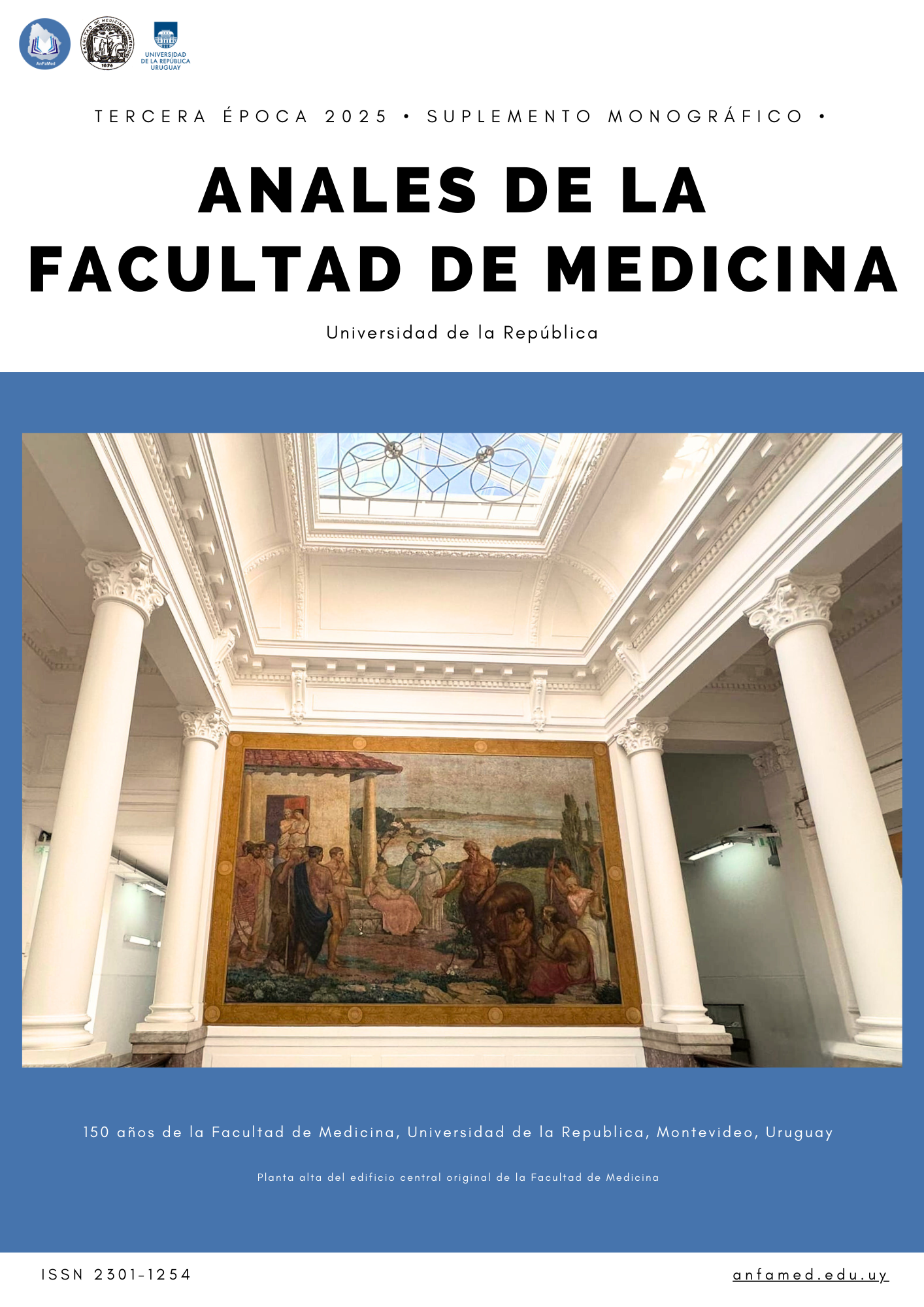Central nervous system infections in post-neurosurgical patients. Intensive Care Unit, Hospital de Clínicas Dr. Manuel Quintela, Uruguay, 2020-2024
Abstract
Post-neurosurgical infections occur in patients undergoing invasive neurosurgical procedures. In Uruguay, they represent 46% of complications. This observational, analytical, and retrospective study, conducted in the Intensive Care Unit of the Dr. Manuel Quintela Hospital de Clínicas from 2020 to 2024, sought to characterize central nervous system infections, with an emphasis on meningitis and ventriculitis.
The objectives were to determine their frequency, identify the most commonly associated type of intervention, the microorganisms involved, the characteristics of the cerebrospinal fluid, and identify factors predisposing to the development of infection and associated mortality. To this end, a review of electronic medical records authorized through informed or surrogate consent was conducted.
Of a total of 236 patients undergoing neurosurgery, 31 were considered for infection. Analysis of clinical, fluid characteristics, and cultures revealed that 21 were confirmed and 10 were probable. Eighty percent were male, and 58% were due to trauma. Gram-positive cocci predominated. Male sex and length of monitoring were associated with infection, while length of monitoring and vascular disease were associated with mortality. Some of the results were biased by population characteristics (especially etiology) and sample size. This is the first study in our unit to analyze this group of patients. The data obtained will inform clinical decisions.
Downloads
References
Coelho E, Costa L, Martins J, Costa M, Oliveira J, Maia-Gonçalves A, et al. Healthcare-Associated Ventriculitis and Meningitis: A Retrospective Analysis. Cureus. 2021 13(10): e19069.
Bertullo G, Moragues R, Lanning L, Reyes V, Oliveira A, Cardozo C, et al. Morbimortalidad asociada al Departamento de Neurocirugía del Hospital de Clínicas. Estudio longitudinal retrospectivo durante el período abril 2017-2019. Rev MEDICA Urug. 2021;37(3).
Bao MY, Xie HT, Gao P, Mao X, Li ZY, Wang WH, et al. Current diagnosis and potential obstacles for post-neurosurgical bacterial meningitis. Eur Rev Med Pharmacol Sci. 2022;26(17):6351–60.
Kul G, Sencan I, Kul H, Korkmaz N, Altunay E. The role of cerebrospinal fluid biomarkers in the diagnosis of post-neurosurgical meningitis. Turk Neurosurg. 2019; 30(4):513-519.
Burghi G, Verga F, Cebey A. Encares de paciente crítico. Primera edición, Vol. 2. Montevideo: Oficina del libro FEFMUR; 2020.
Grille P, Torres J, Porcires F, Bagnulo H. Value of cerebrospinal fluid lactate for the diagnosis of bacterial meningitis in postoperative neurosurgical patients. Neurocirugía. 2012;23(4):131–5.
Puche C. CA, Meléndez F. HJ, Hernández G. LE, García G. LA, Ortega C. CA. Paciente neuroquirúrgico perioperatorio: caracterización demográfica, clínica y factores asociados a eventos adversos. Rev Chil Anest. 2023;52(7).
Algorta M, Wajskopf S. Traumatismo encéfalo craneano. Primera edición. Vol. 1. Montevideo: Oficina del Libro FEFMUR; 2016.
Global Status Report on Road Safety 2023. 1st ed. Geneva: World Health Organization; 2023. 1 p.
Dorresteijn KRIS, Verheul RJ, Ponjee GAE, Tewarie RN, Müller MCA, Van De Beek D, et al. Diagnostic Accuracy of Clinical Signs and Biochemical Parameters for External Ventricular CSF Catheter-Associated Infection. Neurol Clin Pract. 2022;12(4):298–306.
Farina J, Colque ÁM, Castillo MD, Cremona A, Cornistein W, Staneloni MI. Infecciones post neuroquirúrgicas. Puesta al día y recomendaciones intersociedades. 2019; 79: 483-492.
Fernández Moreno I, Píriz Marabaján M. Antisepsia en la manipulación de las conexiones de los accesos vasculares. Med Intensiva. 2019;43:44–7.
Alexandrov, A, Krishnaiah B. Hemorragia subaracnoidea [Internet]. Manual MSD. Revisado/modificado julio 2023 [citado el 15 de noviembre de 2024]. Disponible en: https://www.msdmanuals.com/es/professional/trastornosneurol%C3%B3gicos/accidente-cerebrovascular/hemorragia-subaracnoidea
Copyright (c) 2025 Bruno Deri, Ivana Correa, Matías Cuadro, Paula Camara, Natalia De León, Claudia Chaves, Gastón Burghi, Ignacio Aramendi, Milagros Gómez Haedo

This work is licensed under a Creative Commons Attribution 4.0 International License.
The authors retain their copyright and assign to the journal the right of first publication of their work, which will be simultaneously subject to the Creative Commons Attribution 4.0 International License. that allows sharing the work as long as the initial publication in this magazine is indicated.














